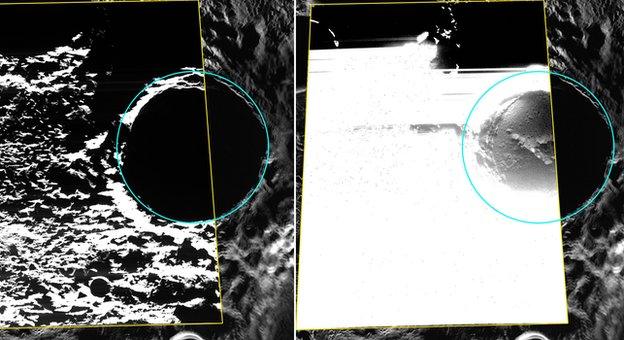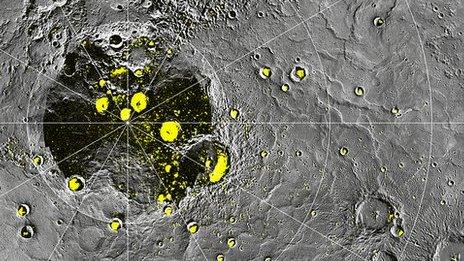Mercury's hidden water-ice revealed
- Published

The image of Prokofiev crater on the right reveals the features of frozen deposits on the crater floor
A Nasa spacecraft has provided the first optical images of ice within shadowed craters on Mercury.
It might seem curious that the closest planet to the Sun - where temperatures soar above 400C - could host water-ice.
But some of the craters on this hothouse world are always shadowed from the Sun, turning them into cold traps.
Using very low levels of light scattered off crater walls, scientists were able to build up a picture of what these frozen deposits look like.
The work, by researchers involved with Nasa's Mercury Messenger mission, has been published in the journal Geology, external.
Scientists suggested decades ago that water ice might be trapped in shadowed areas near the planet's poles. Then, in the 1990s, data from the Arecibo radio telescope in Puerto Rico revealed areas that strongly reflect radar - a characteristic of ice.
Many of these corresponded to the locations of large impact craters mapped by the US spacecraft Mariner 10 in the 1970s.
After the Messenger probe entered orbit around the planet in March 2011, it deployed a range of techniques to show that there are probably several billion tonnes of water ice locked up at the north pole.
In the latest study, Dr Nancy Chabot and colleagues studied an impact crater called Prokofiev, the largest such depression at the planet's north pole.
The uniform surface texture of presumed water-ice areas in Prokofiev crater suggest the deposits arrived relatively recently.
In other areas, water-ice is covered by a thin layer of dark material rich in organic molecules. These dark deposits display sharp boundaries.
"This result was a little surprising, because sharp boundaries indicate that the volatile deposits at Mercury's poles are geologically young," said Dr Chabot.
She added: "One of the big questions we've been grappling with is 'When did Mercury's water ice deposits show up?' Are they billions of years old, or were they emplaced only recently?
"Understanding the age of these deposits has implications for understanding the delivery of water to all the terrestrial planets, including Earth."
Overall, the images indicate that Mercury's polar deposits either were delivered to the planet recently or are regularly restored at the surface through an ongoing process.
Distinctions between the features of shadowed craters on the Moon and those on Mercury may also be instructive about the history of water in the Solar System.
The Moon is also believed to host deposits of water-ice, also being home to areas of permanent shadow. They are also colder than those on Mercury. But there are significant differences in the properties of the surface as measured from orbit.
One explanation could be that the deposits on Mercury are more recent.
"If Mercury's currently substantial polar volatile inventory is the product of the most recent portion of a longer process, then a considerable mass of volatiles may have been delivered to the inner Solar System throughout its history," the paper in Geology says.
"That's a key question," said Dr Chabot.
"Because if you can understand why one body looks one way and another looks different, you gain insight into the process that's behind it, which in turn is tied to the age and distribution of water-ice in the Solar System.
"This will be a very interesting line of inquiry going forward."
Follow Paul on Twitter, external.
- Published22 March 2012

- Published21 March 2012

- Published30 September 2011
